This site contains affiliate links. As an Amazon Associate, I earn a commission from qualifying purchases at no extra cost to you. Full Disclosure Here.
About a month ago, I learned that it was possible not only to test old alkaline batteries to see if they are still are usable but also that, with the right type of charger, you can bring dead batteries back to life and that you can actually recharge alkaline batteries. To be quite honest, I was blown away.
Being a dutiful citizen of the world, when a flashlight, computer mouse or portable electronic gizmo such as a remote control stopped working, I dumped the old batteries into my recycle box and installed some new ones. Of course not being wasteful, I favored the use of rechargeable batteries and was quite proud of my collection of various sized Eneloop batteries which hold their charge for up to three years, even while sitting on the shelf.
First, a quick note on the “tools used” for this project:
- Cheap Battery Tester: Check this one out on Amazon.
- Universal Rapid Battery Charger: Check it out at this Amazon listing.
- Inexpensive Battery Storage Case: This is the one used in this tutorial.
A LADY ON A MISSION
Do you every get a bug in your bum and decide that nothing will stop you from the mission or task at hand? Well, that was me. I wanted to prove to myself that old alkaline batteries were still usable and further, as Dennis Evers (Preparedness is Fundamental) says, you can have free batteries for life.
The first thing I needed to do was to gather up the gear:
Old “dead” alkaline batteries
Battery tester simple enough to use without a Ph.D. in electronics
Battery charger designed specifically for alkaline batteries
Test gear such as flashlights, remote controls, wireless headphones and more
Simple enough although I did have to purchase the tester and the charge. But more on that later.
SORT THROUGH THE BATTERIES AND CULL THE DUDS
For years I have been saving all of my old batteries in a box in the garage, thinking that one of these days I would find someplace to recycle them. Where I live that is easier said than done so the box was pretty darn full which was great because that meant I had a lot of raw material to work with.
My Box of “Dead” Batteries
While waiting for my battery tester and alkaline charger to arrive, I sorted through the box, weeding out any leakers as well as odd ball batteries such as cell phone and hearing aid batteries. According to Wikipedia, the reason a battery leaks is this:
As batteries discharge — either through usage or gradual self-discharge — the chemistry of the cells changes and some hydrogen gas is generated. This out-gassing increases pressure in the battery. Eventually, the excess pressure either ruptures the insulating seals at the end of the battery, or the outer metal canister, or both. In addition, as the battery ages, its steel outer canister may gradually corrode or rust, which can further contribute to containment failure.
Leaked Battery – Yuck
Surprisingly, most of the batteries in my box were clean. Something to keep in mind as you go through the sorting process is that if there is even a single leaker in the box, the residue can spread on to other batteries so it helps to have a rag handy to wipe each battery off to see if it is okay. If you even suspect that a battery has leaked, or if shows any rust or corrosion, don’t take a chance. Throw the baddies back into the recycle box.
WHO SAYS THAT DEAD BATTERY IS REALLY DEAD?
I purchased an inexpensive battery tester from Amazon. There was nothing special about it and it was easy to use. Plus, it had the ability to test 9V batteries as well as button batteries and the traditional AA, AAA, C and D sized batteries.
Simple Battery Tester
I then set to work, testing each and every battery in my box. Much to my surprise, there were a number of batteries that tested “fully charged”. It is interesting to note that many were 9 Volt batteries that came out of one of my carbon monoxide detectors. This leads me to believe that the detector is bad and not the batteries.
Furthermore, I now believe that what commonly happens is that, for example, a remote control or flashlight is dead. You dump the batteries into the recycle box and install new ones. Easy peasy. But in truth, perhaps only a single battery of the 2 or 3 are bad so in effect, you are dumping out 1 discharged battery and 2 or 3 perfectly usable batteries. I even proved this myself. Since I now keep one of these $8 testers in my desk drawer, when my wireless mouse died a couple of days ago, I found that only one of the two AAA batteries that I had removed was dead. The other was showing almost a full charge. Go figure.
The other thing, and something that makes me feel careless and stupid, there were some perfectly good rechargeable batteries in the box. Now, how the heck did that happen?
These were good!
And I thought these batteries were dead.
LET THE RECHARGING BEGIN
After reading reviews on various rechargers, I settled on the Maximal Power FC999 Universal Battery Charger. It wasn’t the most expensive available but according to a couple of the reviewers, this unit was exactly the same as a higher priced model. The difference was that this one is black and the other one was gray.
Maximal Power FC999 Universal Battery
Now here is the deal with this charger. It has four separate charging chambers that operate independently of each other. This means that you can mix and match battery sizes (AA, AAA, C, D) without a problem. It also has a center 9V battery chamber but I have not been able to figure out whether that piggybacks upon one of the adjacent chambers or whether it operates separately.
Note: this charger can also be used to charge Ni-cd and Ni-MH batteries but I only tested it on Alkaline batteries. There is a slider switch that allows you to select the type of batteries you are charging – they can not and should not be mixed and matched by type (although, as I mentioned, various sizes of the same type work just fine.)
There is no question that I experienced a bit of trepidation when I inserted the batteries into the charger for the first time. But there was no smoke and no explosion so I continued on.
A few seconds after you insert the batteries, the tester will recognize the status and the LED window will either say “CHA” (for charging) or “BAD” (for sorry, this is a bad battery and it cannot be charged). In addition, the following lights will glow:
- Red – Charging
- Green – Fully Charged
- Red Flashing – BAD
As I mentioned above, each of the four chambers operates independently so you could have a combination of these three options all going at once.
There is a chart in the manual that indicates that an AAA battery will take 2.5 hours to charge, an AA 5 hours, a C size 6 hours, and a D sized 10 hours. In my experience, however, they charge to the fully-charged, green light stage a lot sooner than that. Now here is the thing. Once fully charged, the charger switches to a trickle charge to keep the battery “at its optimum capacity” whatever that means.
My experience is that if you leave the recharged batteries in the charger overnight – or say for about 10 or 12 hours – you will get a much stronger charge. I say this because I first tested some batteries right after the green light came on. On my tester, they would register at about the half way mark in the fully-charged area. If I put them back in the charger, the green fully-charged light would come on right away but when I took them out the next morning, the tester showed them about 90% charged.
These batteries have been re-charged and are now usable
After doing this a few times, I realized that next on my bucket list was a tester that would give me the actual voltage of the re-charged battery. My brother and nephew – both electronics wizards – have one and tell me that is the only way to truly test the remaining juice left in a used battery.
OTHER TESTING NOTES
The little manual that came with the charger stated that alkaline batteries can be charged to 75 – 90% of their original capacity. It further said that the batteries should be fully drained before recharging but I found that as a practical matter, the fully drained batteries came up “BAD” and could not be recharged at all.
There is one more rather important note that I want to make. I checked on my recharged batteries about two weeks after storing them in a box in my utility cupboard. Much to my surprise, there were some new leakers. Now whether these were overlooked initially (had I wiped away the residue not realizing they were compromised) or a byproduct of the charging process – I do not know. Even more curious, they were all the Costco Kirkland brand batteries.
I had good luck charging the Duracell batteries
The manual also indicates that alkaline batteries should not be recharged more than 30 times. 30 times – holy moly – that seems like a lot of charging to me. For now, I will charge them once until I go through the pile and then start anew. But 30 times? I am going to play it safe and protect my devices by recharging no more than a dozen times if that.
SO REALLY, HOW DID THEY WORK?
Using the recharged batteries on low power devices such as mini LED flashlights and of course, my computer mouse, worked great. As a matter of fact, I can not tell the difference between the recharged Alkalines and standard rechargeables. On the other hand, the Survival Husband uses wireless headphones to watch TV and the recharged alkalines only last abut 8 hours as opposed to the typical 15 to 20 hours with standard Ni-mh rechargeables.
Flameless candles have burned steadily for 5 days
The recharged 9V battery worked especially well on my little Blocklite flashlight. This little flashlight has been on 24/7 since March 9th and today for the first time I noticed the LEDs starting to fade when all six LEDs are on. When I turn the switch to 2 LED mod, it is as bright as ever.
Blocklite Mini Flashlight in Day 7
Clearly, for now, at least, it appears that the recharged alkaline batteries are best suited for low-drain devices.
STORING THE BATTERIES
I purchased these inexpensive storage cases for my recharged batteries. They are really quite handy and I like that the six individual cases interlock and connect together to make a larger case. The rest of my spares are in the plastic pencil case you see pictured above.
I like these mini storage cases.
THE FINAL WORD
For a total investment of about $34, I now have what for all intents and purposes, a lifetime of free batteries. The reason I say “lifetime” is that my friends have indicated a willingness to give me all of their dead batteries and you can bet that many will still be either good as is or eligible for recharging.
Would I trust these recycled batteries in a survival situation – sure, if that is all I had, But of course, that is not the case. I still have a large supply of brand new alkaline batteries in all sizes plus a good supply of standard rechargeables (you know how I love those Eneloop rechargeables).
But as spare batteries to use day to day, heck, these are great. As my tests have proven, a recharged alkaline battery can keep a small LED flashlight going to over a week and a computer mouse for much longer than that. As a matter of fact, you might say I have become obsessed with using these recharged alkaline batteries. But that, of course, is a story for another time.
Additional Resource: If you also want to create the ultimate battery charging batteries with different power sources and methods, check out this resource on the best charging set-ups.
Bargain Bin: Here are links to the products mentioned in today’s article. I do hope you will consider the battery tester – it will definitely pay for itself by preventing you from recycling perfectly usable alkaline batteries.
Maximal Power FC999 Universal Battery Charger: This nicely built charger will charge AA, AAA, C, D, N, 9V, Ni-MH, Ni-CD, and Alkaline batteries. It has an LED display so that when you first put a battery in the charging bay, you know whether it is viable for charging or simply bad and ready to go back to the recycle box. Note: When I purchased the charger, it was on back order. Oddly, it actually shipped the next day. Go figure. Anyway, I am really sold on this charger and can recommend it without reservation.
Blocklite Mini Compact Size Ultra Bright 9V LED Flashlight: One of my readers (James) turned me on to these nifty little LED flashlights. They were great with re-charged 9V batteries. There is a similar flashlight called the Pak-Lite (which is more expensive) but it does not have a high-low switch like this one.
SE BT20 9-Volt Battery Tester You definitely should consider a battery tester even if you decide not to re-charge your alkalines. The advantage of having a tester is that when a gizmo dies, you can determine whether just a single battery is discharged and not the complete set.
SODIAL(TM) Battery Tester Volt Checker for 9V 1.5V and AA AAA Cell Batteries: This tester has a numeric display – something worth considering although may take two to three weeks to arrive.
AA / AAA 4 Cell Battery Storage Case (Bundle of Six Cases): I like these little cases. I put a sticker on the outside of the case indicating that these are re-charged batteries.
And for traditional rechargeable batteries:
Solar 11-in-1 Battery Charger: This is a universal charger that does what it is supposed to do. It uses sunlight to generate a current that charges pairs of batteries in sizes AAA, AA, C, or D and works great with my favorite Eneloop batteries.
Sanyo Eneloop 1500 Super Power Pack: This kit has it all, including 12 AA, 4 AAA, 2 C and D Spacers, a 4 position charger and storage case. This is the kit that I own.
~~~~~


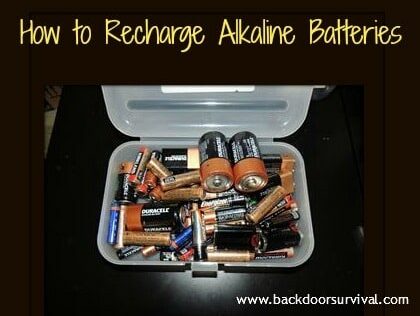

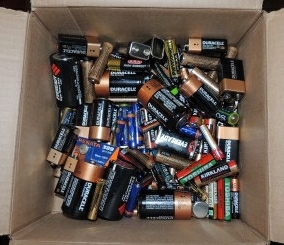
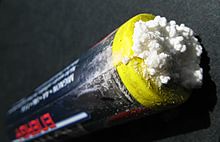
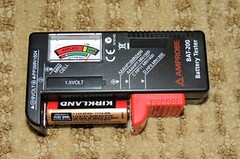
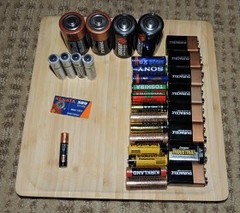

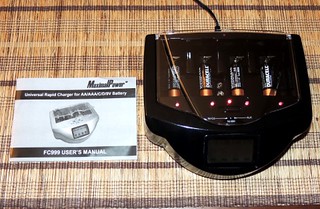
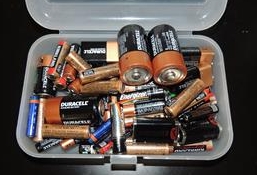
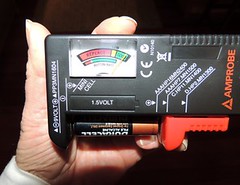
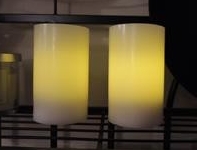



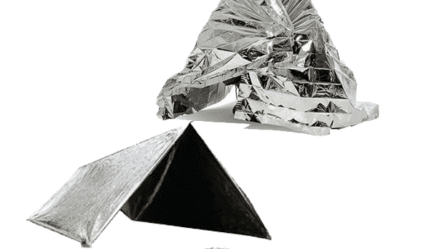






139 Responses to “How to Recharge Alkaline Batteries”
You do indeed have a flashlight fetish.
Not to do with recharging, but just a suggestion for those of you who are prepper types. I did a 9 month wilderness experiment a couple of years ago and made the mistake of not packing enough AA batteries for my radio, I had plenty of AAA batteries, but AA’s were all gone, I found that by placing an AAA battery negative post down inside a .45 Colt cartridge it makes the AAA fit perfectly inside the battery compartment of the AA powered radio.
Interesting and potentially useful blog post. Here is the truth about the process you are promoting here. Non-rechargable batteries are exactly that, non-recgargable. They produce electrical current by a non-reversable chemical reaction. You and others are simply and absolutely not “recharging” them. Your 9th grade chemistry should have passed along the concept that heat is capable of driving, or accelerating a chemical reaction. The “chargers” being employed are merely warming the non-rechargable cells by passing an electrical current through them and driving the last available limited bits of chemical reactants into the one-way, power producing equation. This uses by far more electrical energy that is available in what little chemical is left. This is also why the warming method posted by Mr. Peter Hughes on 5/3/15 works. It is a good technique to remember when nothing else is available, but you run the serious risk of fire, poisoning, chemical burns and destruction of precious electronics or electrical devices as a result. Please use caution, or better yet be prepared with the better alternatives to this risky process.
Um…No….completely and utterly wrong. I have recharged these alkalines that you say “cannot be recharged”, and stored them fro months…and still fully charged…. Please, before you go passing yourself off as some kind of “know it all” at least have some reasonable idea about that of which you are speaking. This segment came directly from WIKI…”…As an alkaline battery is discharged, chemicals inside the battery react to create an electric current. However, once the chemicals have reached chemical equilibrium, the reaction stops, and the battery is depleted. By driving a current through the battery in the reverse direction, the equilibrium can be shifted back towards the original reactants. . My point has been made…
Some alkaline soil do recharge especially the ones I charge with a 12 volt solar panel 10watt small low power. Slow is the key here so they do not over heat and leak.
Soil = ones
Gaye,
I recently bought one of the Maximal 999 chargers specifically because of its capability to charge alkaline batteries. WOW. With 3 grandkids (plus our own devices) we really eat AA and AAA batteries. We have already been saving some on recharging the alkaline batteries. It even charged an old alkaline I found in a desk drawer that has been discharged for at least 3 years. It charged it up. It does not hold a good charge but that is the battery, not the charger. The alkalines are not as strong as when they were fresh (probably 60%-80% depending on the battery), but for most uses, it is cheaper to recharge an alkaline than buy new ones. Thanks for the recommendation and evaluation.
I have to agree with the guy about Kirkland batteries. For years,
Kirkland brand was my go to brand but this past month, I opened up my cabinet to get some batteries and all my Kirklands still in the package were leaking. Then noted that the batteries in my various remotes and flashlights that had failed were also Kirklands. Took the package of bad ones back to Costco and they would not refund me since I didn’t have a receipt for them despite the fact the name Kirkland was printed on the package and the batteries. Was very disappointed in Costco.
Now, only Duracells for me.
I am shocked about Costco not accepting the return without a receipt. When I have a return and there is no receipt, they look the item up in my member sales record and there is never an issue. I refuse to use Kirkland brand batteries for all of the reasons you have stated. They have actually ruined some of my electronics.
i found a product…called mighty Charger you can get it on amazon…it charges regular batteries and it works i have bought 3 of them and i plan to buy a couple more it allows me to use regualr batteries and regarge them…its great for the kids wii i get multiple uses from regualr batties they dont have to be recharables it does aaa aa and 9 volt the thing is great, the first one i had lasted about a year before a couple of the prongs broke, but that was more due to my under 12 children using it than the product it self. i was so happy i bought 2 more and i plan to buy another 6 of them and build a charger box connected to a solar panel the great thing is i can stock up on regular batteries at a fraction of the cost of rechargables…do they last forever no, but an i havent done a hard test but like i said the kids use these in their wii remotes, which suck the power out of them, i also use them for my led flashlights…anyway i get mine on amazon, it think the last time i bought them they were like 15 bucks….was hesitant to pass this along as it might drive up the price and limit availability to my self
I just ordered this one for testing. Link
DO YOU KNOW OF ANY WAY TO CHARGE HEARING AID BATTERIES? I AM CONCERNED OF AN EMP AND CANT GET BATTERIES THANKS JOYCE
No idea how well these will work, but a quick Google search turned up this link:
//www.microbattery.com/products/rechargeable-hearing-aid-battery-charger
Power One Accu Plus rechargeable hearing aid batteries are the only nickel metal hydride (Ni-MH) rechargeable batteries on the market. These quality-made batteries are designed to replace zinc air batteries and must be used with a Power One Accu Plus charger, an exclusive Power One design. The portable Pen Charger charges one NiMH button battery from 2 AAA alkaline batteries for around five hours. The new portable Pocket Card Charger can fully charge two batteries in only two hours. Batteries can be charged more than 600 times on these chargers. Complete instruction manuals accompany all charger models.
An addition for any who may be interested.
As you’ll probably have heard the ecig fashion has caused some interest in charging high demand rechargeable batteries. Charging such high-capacity cells could be ‘problematic’ and so there are now ‘charging bags’ available (bags that you enclose your charger in which protects against unwanted ‘side effects’ should the battery vent or explode (they’re available via Amazon of course).
As capacities of even normal rechargeable batteries increases (I recently purchased some AA’s with a rated capacity of 3200 mAh) it’s always better to be safe than sorry, no? And when mitigating that minor risk is so cheap …
As an aside, I’ve tried multiple chargers powered via a hand-crank generators (rated at both 1W and 2W output) and all appeared to function fine (solar isn’t really an option in the ‘it’s permanently raining here’ UK), although it’s a ‘lot’ of effort over an extended period (I do ten minutes on, ten off, as and when I can when ‘in the field’). And now trying with normal Alkalines too.
What preps did I do this week? I found you of course!
I’m generally squared away on most areas (other than being in the ‘wrong’ country – The UK – I’ve tried to emigrate but The INS just ‘giggles’ when they see my application. Sigh!). I have the basics, backups in most areas, and even backups for my backups (I’m ex-forces/ex-nurse so “one is none …” and “Murphy” are rules I’m always aware of, and being single makes things easier, and remains my one major ‘weakness’). But knowledge? I have questions, concerns, clarifications (How do I? Is there a better way? What are all the options?) galore so I spend (probably way too much) time on the web ‘picking other peoples minds’.
Well, I’ve read Survivalblog (and others for years) and followed a link here, and ….
I just wish to Thank You for answering questions I had, and even some I hadn’t even thought to ask (and incidentally losing two or three hours of my day when I first found your blog). So keep up the good work! (I now have a file of copied ‘knowledge’, ‘research’ and ‘hard-won experience’ entitled “Gayes Tips” near the front of my library. A ‘go-to guide’ I hope will continue to be expanded for years to come!).
Oh, and I (guiltily) ‘found’ that I too (despite having three chargers – and a wish, after reading here, for yet another) have a sizeable collection of drained batteries. Sigh! I reassure (excuse?) myself with the thought that “If all your batteries are charged – you probably haven’t got enough batteries” though.
Great comment, Alec. Made me laugh a couple of times, too. In a good sort of way.
Helot
Hey, laughing is OK, I’m used to it (although generally it’s ladies, and they usually wait until after I ask them for a dance/date first. Sigh!).
I’m renowned for my sense of humour too. Hardly a day goes by without someone (often complete strangers) approaching to tell me how full of wit I am (at least I ‘think’ it was ‘wit’ they said!).
Well, I for one, thoroughly enjoyed your initial post and reply. Welcome and I look forward to your future contributions!
On your tip: Prepare Your Family for Survival: Tip #5 If you purchase from first-aid-product.com They will send you an email when your purchases may be expiring. I purchased from them for one time use for the grandchildren’s first aid kits.